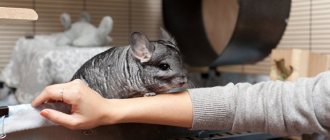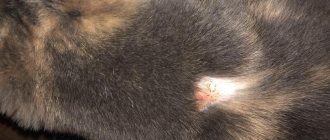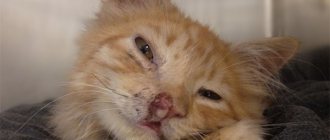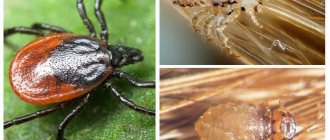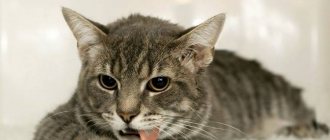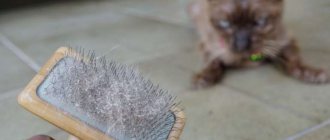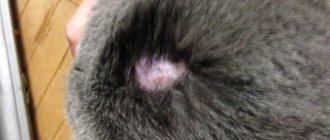When a charming furry pet begins to lose hair, the owner’s natural desire is to quickly understand why the hamster is going bald. There are so many possible causes that it is best to consult with your doctor before starting treatment.
Hair loss associated with skin inflammation is always accompanied by itching. If your hamster itches and goes bald, you must first rule out parasites.
Treatment of hamster baldness
If you can already guess why your hamster’s fur is falling out, then first of all you need to remove the irritant.
If the hamster begins to go bald after some changes, then everything needs to be returned to its place. It could be a new bedding that doesn't suit him. A new diet, products from another supermarket or cheaper analogues. New things in his cage. If, after adding new items to the cage, the hamster begins to go bald, you must urgently remove everything new from his house. If you have no idea what could have caused your hamster to become bald, take it to an animal clinic. There you can get the following and diagnosis advice from a veterinarian.
Poor nutrition. If the veterinarian discovers that the cause of the disease is poor nutrition, he will prescribe the following. First of all, change your diet. It is possible to transfer the animal to a separate diet. Often a green diet can be prescribed with the addition of a variety of foods that hamsters can eat. If the cause is detected correctly and on time, then baldness will disappear within a month. The first signs can be seen after 1 week. The disease will stop developing, the affected areas will gradually heal.
Fungus and lichen. If these diseases are detected in a rodent, the veterinarian will prescribe a special ointment for the detected irritant. Often this ointment is sold directly in the clinic itself in a special pharmacy. It is intended for application to those places that have already suffered from irritation, that is, those where hair falls out. After this, the smearing procedure must be repeated until the baldness process stops. Although even after stopping, you can carry out several repeated prophylaxis for a one hundred percent guarantee. not a little, but it can be treated.
Allergy. If the cause of your hamster's baldness is allergies, first of all you need to find out what it is from. The causative agent of the allergy is not easy to detect. Remember what changes were in the cell a few days before the onset of the disease. All changes that have been made must be returned back. If the reason is not known, then we will start from the most contact areas. First, change the cage filler; it is advisable to clean it well of all residues. And after that add a new one that you are sure of. It is also advisable to disinfect the cage and everything in it. A special product is used for this; it can be purchased at a veterinary pharmacy. An animal may simply not survive bleach and other products that a person uses on himself. Since a hamster can have allergies not only due to external factors, you need to check what you give him to eat. Perhaps that is where the dog is buried. Perhaps you are giving food that he simply should not eat. It will be useful for you to read the article:. For prevention, you can switch the patient to dry food and water for a while. If the reason was in the diet, then after he stops eating the irritant, he will quickly feel better.
Reason not found. If the cause of hair loss in a rodent is not found, then stress is most likely to blame. In this case, your pet needs rest. Give him a break for a few days, including from yourself. Let him come to his senses. Let him again become this interesting little creature that you once acquired.
Every hamster owner whose pet has lived for more than a year has at least once wondered why the hamster's hair falls out. This is not always a sign of pathology - hair loss can be a sign of molting, a natural process for animals.
To determine whether to contact a veterinarian, the pet is carefully examined and its behavior observed. If you are absent, there is no need to rush to the clinic. A veterinarian, having ruled out the most common causes of skin problems in rodents, can only guess why a hamster sheds. It is useful for the owner to know about the conditions that provoke hair loss.
Increased hair loss is not always accompanied by. Signs of molting are shreds of fur in the cage, hairs on the palm after the animal has sat in your arms or been stroked.
Age
A natural phenomenon is hair loss in old hamsters. Your pet has been living with you for more than two years; it has no skin diseases, but its fur is thinning. The reason lies in the fact that hamsters, on average, live three years.
One year for a hamster is like our twenty-five years. Some people start going bald after thirty. A two-year-old hamster is like a fifty-year-old man. Your beloved furry pet is just getting old. And, sad as it may be, the fur thins out only due to the hamster’s advanced age.
This is the case when your pet's fur loss is not a concern. Your task is to care for your hamster so that he comfortably lives out his hamster life.
Allergic reactions and stress
Sometimes a hamster's fur will fall out because it has an allergic reaction. The problem is that identifying it is much more difficult than it might seem at first glance. You need to pay attention to what new has appeared in the animal’s cage. Perhaps it's all about the new diet or arrangement of the cell. In such cases, it is necessary to immediately return everything back so as not to provoke the animal into suffering.
You should also wash your pet's cage regularly, but without using chlorine, as it is dangerous for rodents. In order to correct a nutritional error, you should switch your hamster to dry food.
If the problem was stress, then you need to analyze what new things you did for your pet. Perhaps he did not like the new habitat or the constant noise. At such moments, you should put the cage in its old place and protect the animal from strong noises. You will soon notice that his condition has returned to normal and his fur has stopped falling out.
How to prevent hair loss in hamsters
To avoid a situation in which you have to quickly find out why your pet is going bald, you need to:
- first of all, create decent living conditions for him;
- maintain a balanced diet for your little pet;
- prevent stress from occurring in the animal;
- ensure hygiene and cleanliness in the cage or aquarium;
The hamster is a cute little animal that is loved by both children and adults. But, alas, he is not a long-liver.
https://slonvkvartire.ru/homyaki/pochemu-vypadaet-sherst.htmlhttps://homjakam.ru/bolezni/pochemu-u-homyaka-vypadaet-shersthttps://pets2.me/bok/1428-vypadaet-sherst- u-homyaka-pochemu-i-chto-delat.html
Why does a hamster bite
Hamsters, including domestic ones, are primarily rodents. It is in the hamster's genes to bite any object that catches its eye. But why does your beloved pet, who has been living with you for many months and is accustomed to your hands, bite? Below we have described the most likely and common causes of bites:
Hamster teeth grow quickly and need to be ground down using twigs, roots or mineral stone.
In the absence of this, the animal gnaws on everything, including the owner’s hands. You are picking up the hamster incorrectly - it is preferable to place your hand so that the pet can climb on it, or take it from the side, if you take the rodent from above, it will get scared and may bite. Your hands smell like food - be sure to wash your hands thoroughly before handling your pet. The rodent studies the surrounding space, testing everything to its teeth - in this case, the main thing is not to scare the pet with your scream and switch its attention to another object. The animal is experiencing stress (for example, a change of place of residence) - if possible, eliminate the causes of stress; if this is a move, do not touch the hamster for several days, avoiding cleaning the cage. Pregnant and lactating females may show aggression instinctively in order to protect the offspring - this will pass when the young grow up. During this period, you should not try to pick up the animal.
You can train your hamster to stop biting at home in several stages.
- Use of treats. We take nuts or seeds in our hands and smoothly insert our hand into the cage. The hamster will smell the food and move closer to your hand. At first, we leave the treats in the feeder while the animal gets used to the sight of the hand and the smell.
- When the pet becomes bolder, we wait for him to try to climb onto your hand with a treat. For some time you will need to let him stomp on your palm and eat the treat.
- When this stage has been passed, you can lightly stroke the animal’s back. But under no circumstances touch your head.
- After getting used to all of the above actions, you can try to pull the hamster sitting in the palm of your hand out of the cage and pick it up.
It is important to do everything slowly and carefully, with a lot of patience. Always approach the cage in such a way that the rodent can see you
Attempts to take him from behind will lead to aggression and repeated bites.
Second weaning method
There is another way. Using a scoop or similar object, you need to remove the hamster from the cage and place it on the bed or floor - any flat surface. First, let the animal walk around on its own so that it can sniff everything and feel safe.
Note! Before releasing the rodent from the cage, prepare an area for it in advance, fence it off on all sides so that the hamster does not escape. Finding and catching a rodent in an apartment is quite difficult! After a while, block the rodent's path with the back of your hand
The outer part of the palm will look more like a regular barrier, while the inner side will frighten the animal. A rodent may associate splayed fingers with the fangs of a predator - this is an instinctive reaction
After a while, block the rodent's path with the back of your hand. The outer part of the palm will look more like a regular barrier, while the inner side will frighten the animal. A rodent may associate splayed fingers with the fangs of a predator - this is an instinctive reaction.
Once the hamster decides to bite you, blow on it slowly and evenly. He won't like air directed at his muzzle. After this, move the rodent back to the cage and repeat the lesson the next day. After a few days of training, the pet will develop a reflex: an attempt to bite the owner’s hand causes an unpleasant wind. Then the animal will understand that it is better not to bite.
Both methods may not bear fruit immediately. And you need to choose an approach to a specific animal.
Prevention
The disease is easier to prevent than to treat. With regard to skin diseases in rodents, the following measures must first be observed:
- do not approach the hamster in street clothes and shoes;
- handle your pet with washed hands;
- follow quarantine rules after acquiring a new animal;
- maintain the animal’s home in good sanitary condition;
- protect your pet from stressful situations.
If trouble happens and the pet dies from skin problems, then before purchasing a new hamster you need to do a general cleaning of the room and thoroughly disinfect all equipment and the cage.
The health of pets depends on the owner
Inattention and negligence can destroy even such an unpretentious creature as a hamster
Course of the disease
The incubation period can be long. The first signs are round, flaky areas that look like they have been shaved off. The hairs at the base break. The affected areas become inflamed and turn into ulcers. Ringworm in a hamster can occur in a latent form for several months during the incubation period. Only after this you will see the first symptoms.
Pus begins to ooze from the ulcers, after which a dense crust forms. The disease most often affects the muzzle, areas near the ears and sides. But even one outbreak is enough for the disease to spread throughout the body. Constant scratching contributes to this. It is quite difficult to cure, so when the first symptom appears, run to the hospital.
Causes of loss
A healthy and active hamster loses its hair
If the animal behaves as usual, it moves actively and eats well, but the owner notices that its fur is simply “falling off,” then perhaps it’s all about molting. Seasonal coat changes are typical for animals in the wild.
In indoor conditions, this process is more extended, although very often it goes almost unnoticed. In this case, everything is individual. You can also distinguish seasonal shedding from pathological baldness by the color of your coat.
During the period of molting on the animal, the hairs differ in color. Bald spots as a result of shedding are most often noticeable on the stomach and the inside of the legs. This is much less noticeable on the back.
What to do if your hamster hibernates?
Why do hamsters go bald at the age of 2-3 years?
A pet can lose hair from old age. If a pet has celebrated its second or third birthday and its fur has become sparse and coarse, and skin diseases are excluded, then there is only one reason - old age.
In this case, the aging process cannot be stopped. Hair loss does not bother the pet and it is enough to organize good care so that the animal lives out the allotted time in comfort.
How long do hamsters live?
Hair falls out and skin peels
When hair loss is accompanied by peeling skin, the owner has real reasons not only to worry, but also to contact a veterinarian.
Many people put off visiting the clinic, blaming everything on allergies. Losing time can negatively affect the health of the rodent. After all, in addition to allergies, the cause of baldness is damage to the skin by microscopic fungi that cause lichen. Most often we are talking about trichophytosis or microsporia.
Areas without hair are round in shape and broken hairs are visible. They appear near the ears, on the face and sides. The skin is smooth at first, but as the disease progresses it becomes inflamed, and suppuration and scabs may appear.
Very often, the causative agents of lichen get onto the animal from clothing or human hands.
In advanced forms, the animal loses its appetite and behaves aggressively. The diagnosis is made by a doctor, who also selects adequate treatment.
Hair falling out on the hamster's back
Only a doctor can prescribe treatment. Small seals without hair appear on the rodent's face. Gradually they merge into more extensive scabs and affect the back of the animal through the neck and withers.
The cause of the appearance of bald spots on the back of the animal is microscopic mites - demodexes. With this pathogen, itching is rare.
An accurate diagnosis is made by examining skin scrapings under a microscope. Treatment is prescribed by a doctor after identifying the pathogen.
Skin parasites in hamsters as a cause of baldness
Parasites cause itching. The following parasites can settle on the skin under the fur of a rodent:
- scabies mites;
- lice eaters;
- lice;
- fleas.
The main symptom of the disease is itching. The animal is itching desperately. In areas of scratching, not only hair falls out, but also inflammatory processes begin.
Once the diagnosis is made, the veterinarian will prescribe contact insecticides. It may be necessary to treat the animal for worms before using them.
When treating with drugs for internal and external use, you need to take into account the size of your pet.
Other reasons
If hair falls out in the tail area, lower abdomen, or on the inside of the hind legs, then the reason is frequent urination. It is caused by diseases of the genitourinary system. An upset bowel movement can cause hair loss in the anal area. Only by eliminating the underlying disease can hair loss be stopped.
A stressful situation, feeding low-quality food, intoxication can also cause hair loss.
Why does the dzhungarik go bald?
Follow the correct diet. One of the reasons for the loss of hair in the dwarf dog is errors in nutrition. It is advisable to reduce foods high in carbohydrates, remove whole grains and exotic fruits, and add fresh herbs, crushed grain mixtures and oak or hazel twigs to the diet.
The diet must contain protein foods. Even a piece of boiled chicken will do. Protein should be about 15% of the daily diet.
Why does the Syrian hamster go bald?
If areas without fur appear on the head or face of a pet, then mechanical abrasions on the bars of the cage are to blame. To avoid this, try to replace it with a special terrarium, where the lower part is solid and made in the form of a tray.
Watch your pet. If a Syrian or other hamster has recently appeared in the house, stress and the transition to a new diet are to blame. After 10 - 12 days the animal gets used to it, and the hair loss stops.
Why does a hamster go bald?
First aid
Finding out the causes of baldness
It is not always possible to seek help from a specialist. After all, not every locality has a veterinary clinic. What to do in this case? If your hamster is going bald, you will have to take remedial measures yourself. The causes of hamster baldness should be excluded and checked gradually and in order.
Filler
This is the first thing you need to pay attention to. There are many good and not so good fillers. Some of them can cause an allergic reaction in a pet and the development of infectious diseases. Whatever the filling in the cage, at the moment when the animal itches and loses hair, it must be completely removed.
But leaving your hamster without any flooring is also not a good idea. The best material in this case would be paper. You can use napkins or toilet paper. The main condition is that such material must be white, without any inscriptions or images, as well as without flavors or dyes.
Cell disinfection
Clear the rodent's home of all objects with a porous structure - stones, twigs, etc. Carry out a general cleaning of the cage with disinfectants. You can only use a weak solution of potassium permanganate or soda solution.
Article on the topic: How to euthanize a hamster at home, euthanasia under anesthesia
Thoroughly rinse all the equipment - the wheel, drinking bowl, feeders and other accessories that are available in the rodent's house.
Diet correction
During the period when the Dzungarian, Syrian or other species of the Hamyakov family goes bald, great importance should be given to its nutrition. After all, food is one of the main sources of allergic manifestations, as a result of which the hamster becomes bald.
Wet food should be excluded from the diet, and first of all, fruits and vegetables. At the time of treatment of the disease, limit yourself to dry food.
Also, don’t forget about drinking. The water in the drinking bowl should always be clean and fresh.
Eliminate stressful situations
Some breeders believe that moving or relocating hamsters to another place does not in any way affect the condition and health of the pet. And they are deeply mistaken. This rodent, like any other pet, reacts poorly to changes in environment. And if this happens systematically, he becomes bald.
Also, do not forget that this mammal prefers a solitary life. The proximity of relatives can be a great shock for him, and as a result, the cause of baldness.
Age-related changes
When buying a particular breed of pet rodent, ask how many years it has lived at home. This is very important, because by the time an old hamster reaches this age, it begins to have health problems, and this often manifests itself through baldness of the skin.
The hamster is going bald, we try to treat it ourselves
But, if you can’t turn to a specialist right now, you will have to treat your pet for baldness yourself. Let's look at the possible causes of the disease in order.
Allergy
The litter can serve as a source of infection and quite often leads to allergic reactions in hamsters, which can subsequently cause baldness. The filler can be replaced with regular paper napkins or towels.
To eliminate the possibility of an allergy to the contents of the cage, carry out a general cleaning of it. To begin, remove all contents, litter, branches or stones, and other toys of your pet from the cage. All porous items should be thrown away and replaced with others.
Thoroughly disinfect everything your pet comes into contact with, and also treat the animal’s home! Buy a disinfectant at a specialized pet store and be sure to follow the instructions for using the product.
The use of household chemicals is also allowed. Leave objects that the hamster has come into contact with in the solution for several hours, and then rinse them thoroughly under a strong stream of water.
It would be wrong to use antifungal ointments, and therefore to advise them, because without a thorough analysis it is not possible to establish the cause of baldness. This means that treatment with ointment will most likely not be correct.
Remember, using any medication without consulting a veterinarian can lead to negative consequences, including the death of the animal.
Food poisoning
It is necessary to adjust the rodent's diet. First, you need to exclude fresh fruits and vegetables from your diet. During this period, it is recommended to feed the hamster only with previously tested dry food. Drink exclusively clean filtered water.
Stress is the cause of baldness
The cause of baldness is often stress; the reason for it can be, for example, moving the cage to another place or “sharing” your pet with a neighbor.
Remember, most hamsters do not like company and do best alone. And when a neighbor imposes stress, both rodents will feel stress; the consequence of such stress can also be baldness of the hamster.
A fairly common cause of baldness in hamsters is lichen. With this disease, scales and wounds may form in areas of baldness. It is quite difficult to identify lichen at an early stage; the skin is not immediately affected and visually lichen appears a couple of months after the pet is infected.
To treat this disease, there are a huge number of ointments and creams against lichen, but if this particular disease is detected, we still recommend contacting a veterinarian and immediately isolating the animal.
Well, one last thing: age. Depending on heredity and breed, the life expectancy of a hamster is no more than two years. By that age, there is a likelihood of health problems occurring, in particular the hamster’s baldness. Under such circumstances, it seems little possible to make his life easier. Using a new diet may help correct the situation.
The hamster is going bald, causes, symptoms, prevention, treatment 3.4 (68%) 5 votes
Diagnostics
The most common cause of baldness in domestic hamsters is infection with lichen. Moreover, it is not always possible to determine the presence of lichen in a hamster at the initial stage. Baldness caused by lichen appears first on the back, then on other parts of the body. In areas of baldness, you can notice small scales and wounds from scratching. If an animal constantly scratches due to unbearable itching, it most likely has lichen.
Article on the topic: Why does a hamster itch and bite itself, what to do?
Treatment of a hamster that has become bald from lichen is carried out using special ointments. But you shouldn’t get carried away with self-medication. After all, in nature there are many varieties of lichen. Each case requires individual and well-chosen treatment.
The second reason, which is often accompanied by baldness of a domestic hamster, is an overabundance or lack of vitamins. You shouldn’t stuff your animal with everything in order to get rid of this problem. First you need to establish the cause. For this purpose, the veterinarian conducts an in-depth diagnosis of the pet:
- take a skin scraping;
- will inspect the affected areas under a special lamp.
A comprehensive diagnosis will help determine the cause of baldness, after which a specialist will prescribe the necessary treatment for your animal.
Causes
It is necessary to distinguish between individual keeping of hamsters in a personal cage and group keeping. The reasons for their molting are not the same. So, if the hamster is kept at home in a cage and there are no other animals, hair loss can occur for the following reasons:
- Unbalanced diet.
- Allergy. Reaction to a new ornamental plant, filler.
- Sudden change of food.
- Poisoning by food or vitamin supplement that is unusual for a hamster. The body tries to remove toxic substances in any way, including wool.
- Loss of immunity as a result of illness. Hamsters suffer from overheating more severely than from hypothermia. They tolerate frost, but are defenseless against drafts.
- Unsanitary conditions. The fur becomes contaminated with urine and falls out.
- Stress. Moving, fright.
- Old age. Before death, the fur loses pigmentation and slowly comes out.
- If there is a cat or dog in the house, it is theoretically possible, although unlikely, for fleas to jump onto the hamster.
For group housing in non-residential premises, the following reasons are added:
- With high humidity, fungal diseases develop.
- When a hamster comes into contact with mice, it gets scabies or lichen.
- During lactation, fur falls out due to unbalanced nutrition.
How to identify allergies before buying a pet
There are several ways to determine if your body is allergic to a particular type of animal:
- Brief contact. Symptoms do not develop immediately, but after 4–7 days or more. Before purchasing, pet the animal, hold it in your arms in a store or with friends. After a few days, evaluate the condition of the skin, mucous membranes of the nose and eyes.
- Visit to an allergist. The most accurate way to diagnose is tests. They will allow you to find out which animals are hypoallergenic for you and which ones provoke a reaction. Peak, patch, and provocative tests are carried out by direct contact of a potential foreign agent with the skin.
Many people prone to allergies experience a cross-reaction. If a pathological condition of the body develops on the feathers of a parrot, then similar problems will arise upon contact with other species of birds. The same applies to animal fur.
You should not immediately abandon your pet as soon as unpleasant signs appear. Try to reduce contact with him, thoroughly clean the house, and clear the air of foreign particles.
Source
Viral diseases or fungus
We correctly determine the cause
You can often hear the question of why a hamster's hair falls out. Experienced experts say that this may be a consequence of a fungus or virus. The symptoms of such diseases are that the skin begins to peel off or hair loss occurs.
In order to get rid of such signs, you should buy a special ointment. It is not difficult to buy it at a specialized veterinary pharmacy or from a doctor. It should be smeared on sore areas of the skin. To prevent the recurrence of the disease, it is recommended to use the ointment even after the unpleasant symptoms have disappeared.
What to do
If changing the bedding, good care and a nutritious diet have not stopped the hamster’s hair loss, then a visit to the veterinary clinic is essential. Unfortunately, not all doctors undertake to treat rodents.
Try to find a blade that has a specialist - a ratologist.
If there is no such hospital, the Internet will come to the rescue. Post good photographs of your pet on specialized veterinary websites, describe the problem in detail and get qualified advice.
Why does a hamster lose hair?
Caring owners, faced with hair loss in rodents, begin to look for reasons in the care and organization of the pet’s diet, suspecting them as key factors in baldness. There is some truth in this, but do not rush to blame yourself for the wrong approach to the animal, since the reasons can also be caused by skin diseases, independent of the quality of care
Prompt response to the problem will significantly increase the chances of successful treatment of the rodent, so it is important to know all the possible sources of ill health. Chief among them:
Fungal or viral infection. Infection with a tick or subcutaneous parasite. Food with a high content of chemical additives, which are used in industry to increase shelf life. Manifestation of an allergy to a certain food or a new object in the cage. Lack or excess of vitamins. Individual intolerance to filler components. Severe food poisoning. Stressful situations that can be caused by a radical change in diet, excessive attention or innovations in the cage (rearrangement or addition). Physiological changes due to the age of the rodent. Weak immune system. Taking hormonal drugs. Irregular knitting. Attack by other domestic animals.
Most often, hair loss in rodents, including the Djungarian hamster, begins from the head, eye area and tummy. It is not uncommon for hamsters' paws to become exposed first. If you begin to notice hair loss, inspect these areas first to be sure to determine the presence of the disease.
There is no need to worry about baldness, since in most cases it can be successfully treated. The only exceptions are elderly animals, in which the processes are associated with the approach of death. Common causes include fungi, parasites, and poor rodent nutrition.
If your hamster's hair is falling out and there is damage to the skin, it is necessary to take him to see a veterinarian for a detailed examination and diagnosis. It is advisable not to delay going to the clinic, stretching out the start of treatment for several days. We have clarified what to do if a hamster’s fur begins to fall out and it’s time to find out how to cure the animal.
What are the chances of getting your full head of hair back?
In addition to the above, diseases that cause hair loss include internal and infectious diseases, experienced shock, prolonged depression, deficiency of vitamins and nutrients (especially with mono-diets), etc.
Only a qualified doctor can choose treatment tactics not only for the diseases associated with hair loss, but also for hair loss itself. This may be the prescription of certain drugs (including hormonal ones) that stimulate hair growth, and physiotherapeutic procedures carried out for a similar purpose (laser therapy in this regard is at the peak of popularity today).
But, of course, the most effective and most popular way to restore hair, if medications are powerless and the consequences of the disease have caused irreparable damage to the hair, is hair transplantation. And the best tactic here is HFE technology. Its attractiveness to patients is understandable.
If there is a sufficient amount of healthy hair left on the head (this is determined by a specialist during examination), then using this technique a transplant is performed on the “bald” area. It is done manually using microtools. Thus, the skin is practically not injured. Most often, this procedure (which, however, can take several hours) does not even require anesthesia, and after that the patient immediately goes home.
Trichologists advise not to wash your hair for the first few days so that the transplanted grafts take root and grow. For a more stable recovery, it is recommended to further use medicated shampoos and products that support hair growth.
Trichologist
Possible diseases
One of the most dangerous causes of baldness is disease.
Unfortunately, hamsters are susceptible to a wide variety of ailments. Among the most common are:
- Scabies is a disease where mites infest the skin of the animal. If they are not detected in time, the rodent may lose almost all its fur. The skin becomes inflamed, with traces of scratching. The animal suffers from itching and pain, behaves aggressively and is not allowed to be handled. Treatment aimed at destroying subcutaneous mites will help cope with baldness.
- Ringworm - it is accompanied by peeling of the skin, itching and usually has a chronic form. The hamster quickly becomes bald and itchy, but the bare areas have a regular rounded shape. They are covered with a crust, and the hair appears to be broken off at the root. Treatment of lichen is a long process that involves regular use of antifungal ointments and sprays.
- An abscess is a purulent inflammation of the skin. In this case, not only baldness is observed, but also a change in its color. The abscess opens spontaneously or in a veterinary clinic. When the inflammation is cured, the fur will grow back.
- Irritation from urine - if baldness appears on the hind legs and tummy, the skin is constantly in contact with urine. This is facilitated by a rare change of bedding and a small cage. If the conditions of detention are optimal, hair loss indicates that the animal drinks a lot and pees. This phenomenon is a symptom of diseases such as cystitis, urolithiasis, and kidney failure.
- Mechanical abrasion of fur - keeping a pet in inappropriate conditions can lead to fur loss due to constant external influence. This way, the hair on the paws and tummy is wiped off, but more often the problem is observed on the head, especially if the hamster likes to chew on the bars of the cage. If it is not possible to relocate the rodent, provide it with another object for grinding down its teeth - twigs, hard sticks, mineral stone.
- Hormonal changes – baldness can be caused by disruptions in the hormonal system. Hamsters have polycystic disease and ovarian tumors, endometritis, and inflammation of the uterus. Hair loss is also possible during pregnancy, and during lactation the female's belly becomes completely bare.
- Digestive disorders - if a hamster is poisoned, for some time its fur will not be as thick and shiny as before. This is due to the fact that nutrients are not absorbed and the body weakens. Poisoning from poor quality food is possible. When intoxicated, one of the symptoms is hair loss.
- Dental problems – if the growing teeth do not grind down and the incisors break, the rodent will not be able to eat normally. In addition, increased salivation occurs, which is why the hair on the neck will be wet all the time and will soon begin to fall out.
If any alarming symptoms appear, you should take your pet to the veterinarian. Only a specialist can identify the cause of baldness and make an accurate diagnosis. He must prescribe medications, since it is very difficult to calculate the dosage for hamsters. The doctor, taking into account all the characteristics of the animal, will select suitable drops or specialized shampoos.
We identify risk factors and combat them using adequate methods
A number of factors that can trigger hair loss in young children are similar to those in adults, and some will be specific to a particular age. Let's take a closer look at the main ones.
1) Diseases associated with disorders of the endocrine system, disorders of the liver, adrenal glands or kidneys can, among other symptoms, manifest themselves in hair loss
It should be remembered that while an adult is immediately able to pay attention to changes in health, children, especially young children, can often have difficulty explaining something even to a doctor. Therefore, even if you do not notice any changes in the child’s behavior other than hair loss in children, this is still a reason to consult a pediatrician
Medical and parental attention should be especially close if the child has undergone a course of hormonal treatment.
2) Telogen effluvium is a type of baldness that is especially common in young children. The name of this cause of hair loss in children is taken from the name of the stage of hair growth, namely the period when the hair stops growing for about three months, as if “falling asleep.” This is the final stage of the cycle for one hair. Next comes the repetition of an identical cycle, when new hair replaces the old one. We can talk about telogen effluvium if the hair does not “awaken” in a timely manner. Sometimes, if we are talking about a very young child, this process can improve on its own (but you still need to see a doctor), but more often the condition indicates an excess of vitamin A in the baby’s body.
3) Trauma to the hair shaft is the cause of hair loss in children, which may be due to the effects of exposure to chemicals on the scalp or due to too much mechanical pressure on the hair. This often happens to girls whose parents braid their hair too tightly or use elastic bands and hairpins that damage their hair.
4) Often, children's hair begins to thin and fall out due to a neurotic disorder called trichotillomania. This disease manifests itself in the child’s desire to constantly pull and pull his hair, and quite strongly. If the problem is not identified in a timely manner, it can have far-reaching consequences not only for the baby’s mental health, but also for hair growth itself. With systematic mechanical impact on hair, its growth can slow down and even stop altogether, especially if mini-scars appear as a result of pulling out.
5) Dermatological diseases, in particular ringworm, are another typical “childhood” cause of hair loss in children. The clinical picture in this case is characterized by the presence of first broken hair on the affected area, and then the formation of bald spots, in which inflammation, peeling and severe itching are observed. This disease is a fungal disease, so it should be treated by a dermatologist.
6) Puberty is one of the most difficult periods for a child’s body, when hormonal changes in the entire body take place on “adult lines.” And this can also cause hair loss in teenagers. Increased emotionality often leads to stress, which is known to negatively affect hair follicles.
Cystitis
Inflammation of the bladder or cystitis often occurs from hypothermia. Rodents do not have good thermoregulation, so even an ordinary draft can provoke it.
The most important rule is to protect your pet from hypothermia:
- hide it from the fan and open windows;
- remember its sensitivity to temperature changes;
- protect from drafts.
Simple rules, but how many difficulties can be avoided by simply closing the window in time! With cystitis, a hamster experiences a burning sensation when urinating and constant pain in the lower abdomen. He won’t be able to talk about it, but it’s possible to find out about the disease. As with colibacillosis, cystitis makes the hamster's fur wet. Losing fluid in such quantities can lead to dehydration.
It is because of the similarity of symptoms that you need to seek a final diagnosis from a specialist. If you suspect inflammation of the bladder, you should immediately go to a veterinary hospital, where they will tell you exactly what happened to your pet. Typically, for cystitis, your veterinarian will prescribe antibiotic treatment. To prevent this, it is better to take care of your pet’s health in advance.
Doctor's qualifications
In 2016 she graduated from Voronezh State Medical University. N.N. Burdenko.
2014-2016 attends a surgical club at the Department of Operative Surgery of the Voronezh State Medical University.
In 2022, clinical residency at the Peoples' Friendship University of Russia, specializing in dermatovenerology.
Certified specialist, regular participant in international and Russian thematic professional seminars, forums, congresses on aesthetic medicine, cosmetology and dermatovenerology.
Why does shedding occur?
All animals sooner or later begin to change their fur. Hamsters are no exception. This can occur for several reasons.
- Due to age. The bottom line is that at the age of 5 months, hamsters can change their fluffy fur to denser hair (molting is observed).
- Due to seasonal processes. Hamsters shed only in spring and autumn. This is due to the fact that weather conditions are changing.
Usually the molting process cannot be seen with the naked eye. If your rodent is not sick and is quite active, then there is no need to worry. This is a normal physical process that cannot be influenced. For example, small Djungarian hamsters have only three coat colors. As soon as they “survive” the moult, the number of shades doubles.
